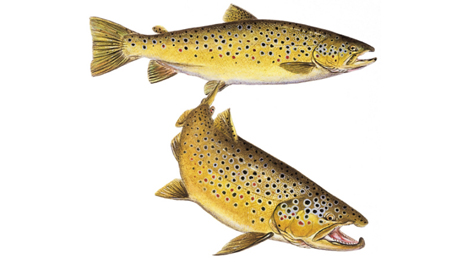Common Names: Brown Trout, German Trout, brownie, browns
Habitat
Brown trout were introduced into Ontario from Germany in 1913. These introductions proved quite successful and brown trout are now considered to be a naturalized species of Ontario. Of the Great Lakes, only Erie and Ontario have brown trout populations. Many of the rivers and streams of southern Ontario host browns. Browns are adapted to similar habitat as that of brook trout, and brook trout are usually pushed to the headwaters of streams were they coexist.
Spawning Patterns
Brown trout spawn in the fall, usually in late fall or early winter. They utilize shallow, gravelly headwaters. Fish seldom mature earlier than age three. A five to six year old female averages about 2,000 eggs. The eggs take between 40-70 days to hatch.
Diet
Brown trout are referred to as opportunistic feeders. Any food source may be utilized if it is readily accessible. Aquatic and terrestrial insects form a large portion of the diet but fish, fish eggs, amphibians and crayfish are also important. It is interesting to note that there is significant evidence that large brown trout only feed at dawn and dusk.
Age and Size
Brown trout have been known to reach the age of thirteen. Fish over 10 lbs. are common in larger waterbodies, but most small streams and rivers have an average size of one to two pounds.
Fishing Tips
Lake Ontario and Lake Erie anglers have had continued success trolling spoons throughout the summer months. This is probably an angler’s best bet to hook a large fish. Many small rivers throughout southern Ontario, however, are more accessible to the vast majority of anglers. Traditional river fishing methods, such as fishing roe or worms under a float, are productive, as is casting small spoons or spinners.
Remember that larger fish tend to feed only during twilight hours, so get out early or stay just past dark for a chance at a larger fish. During the fall, many of the rivers that empty into Lakes Ontario and Erie have spectacular runs when all the big fish move into the rivers from the open water hiding spots.
Fish illustration ©CURTIS ATWATER (www.natureartists.com/atwaterc.htm)









